Last
updated 10 March 2021
DORNIER
Do 27 & Do 28 IN AUSTRALIA & PAPUA NEW GUINEA
Compiled by Geoff Goodall
Compiled by Geoff Goodall
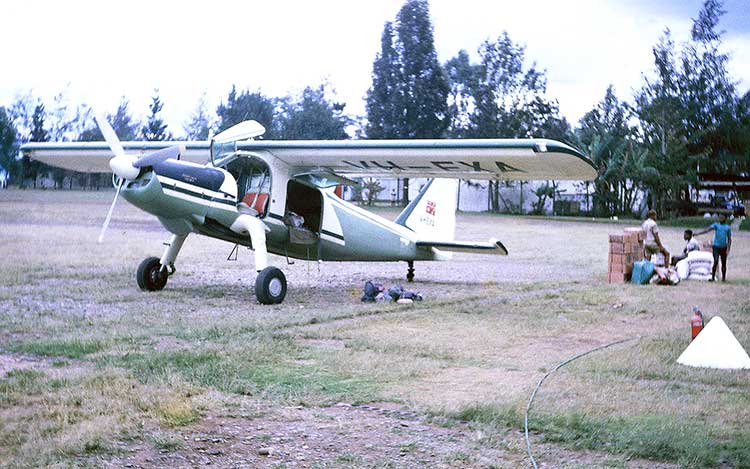
The Do 27 was originally designed as a military utility transport by the Dornier works in Spain, where the prototype first flew in June 1955. Production commenced in Germany by Dornier Werke GmbH the following year, and large military orders were received from the West German air force and army, and military arms of other European countries. Dornier also marketed civil versions, whose all-metal construction, STOL performance, seating for up to 7 native passengers and large upward-opening cabin doors for easy loading of freight made them an attractive proposition for the short airstrips of the New Guinea mountains.
During 1959 American missionary Father Leo Arkfeld, who had been flying in New Guinea for eleven years, was travelling home to USA on leave. While in Europe, he arranged to visit Dornier's works near Munich to inspect the Do 27 to add capacity to the mission fleet of Cessna 170s ands 180s. After a demonstration flght, Father Arkfeld was highly impressed. When he returned to New Guinea, he was negotiating the purchase of two Do 27s, and in agreement with Dennis Buchanan of Territory Airlines, placed an order with Dornier for three aircraft:
Do 27Q-4 VH-IHS for Wewak Catholic Mission
Do 27H-2 VH-CHR for Goroka Catholic Mission
Do 27H-2 VH-GKE for Territory Airlines
As a result of these negotiations with Dornier, the Catholic mission aviation operation Wirui Air Service became the PNG agents for the type. Wirui Air Service was based in a hangar at Wirui airstrip on the edge of the town of Wewak, which had been Wewak's airfield from the 1930s until 1956, when a new Wewak Aerodrome was constructed by DCA on the site of the wartime Japanese strip at Boram, 5 miles from town. By the 1960s Wirui was a small grass strip shared by the Catholic Mission and Missionary Aviation Fellowship (Mafair).
Later in 1960, Bishop Arkfeld sent the Manager of Wirui Air Service, experienced mission pilot and engineer Father Ivo Ruiter to the Dornier factory to learn Do 27 construction and maintenance. Ruiter translated a complete set of Do 27 manuals from German to English for submission to DCA as part of the Australian "first-of-type" certification process.
The introduction of the Do 27H-2 model with super-charged engine, brought many problems. They suffered vapour-locks in the fuel lines which caused the engine to run rough, or fail completely in flight. The fuel system had been designed for European operating conditions, not the hot-and-high tropical weather of the New Guinea highlands where many airstrips were at 5,000 feet elevation or higher. Territory Airlines Chief Engineeer Paul Raasch, who was familiar with German engineering techniques, made a major effort to investigate the fuel line vapour locks in their Do 27H-2 VH-GKE, but TAL decided to sell it after less than a year in service. The fuel line vapour-locks were later solved by the Lutheran Mission engineers, but power losses caused serious accidents and despite the problem being limited to the H2 model, the reputation of all Do 27s in New Guinea was tarnished. The future sales market for Do 27s in New Guinea was lost to the Cessna 185 Skywagon which had the same payload, was faster and used less fuel.
Wirui airstrip at Wewak was closed to operations effective 30 June 1976. The last departure that afternoon was by P2-UIE, the Catholic Mission's last Dornier. Father Ivo Ruiter flew the short hop across to Wewak-Boram Airport which became its new base. It was retired in 1983 when the need for a fleet of aircraft in the New Guinea highlands was reduced due to the gradual construction of a road network in the Mission's area. Wirui Air Services was closed in 1986 when the Wewak mission's air transportation needs were carried out by Mafair - the Protestant's Missionary Aviation Fellowship. Father Pat Fincutter, who flew many hours on the Wirui Air Services Do 27s, later wrote:
"The STOL characteristics of the Dornier Do 27 were much appreciated. Also, with its rugged, heavy duty design and construction and large wheels, it was less affected than other types by the poor surface conditions on some of our airstrips. One drawback for the Do 27 was its free-swiveling non-steerable tailwheel, which was a factor in three landing accidents. The Do 27 required more maintenance work than the Cessna 180. As a result some of the engineers who worked on the Dorniers were not entirely delighted with them. They also preferred the Continental engine in the Cessna, to the Lycoming in the Dornier.
Nevertheless, the Do 27s gave our mission many years of very good service in the difficult conditions of New Guinea. Also, a good amount of charter work came our way because the Do 27 was the only aircraft in our area of the country that was capable and versatile enough to provide the service required."
Do 27 production ceased in 1962 after 628 aircraft had been built. Models certified by Department of Civil Aviation for Australian and PNG use were:
Do 27A-4 Military production: 4 pax, wider landing gear, increased MAUW. 270hp Lycoming GSO-480, two-bladed Hartzell CS propeller
Do 27H-2 Civil production: enlarged tailplane, 340hp supercharged Lycoming GSO-480. three-bladed Hartzell CS propeller
Do 27Q-4 Civil production: 5 pax with addition fuel tankage, 270hp Lycoming GSO-480. two-bladed Hartzell CS propeller
| .60 |
Built by Dornier-Werke GmbH at Oberpfaffenhofen Airport, Munich, West Germany. Civil production. |
| Ordered as a new aircraft by Catholic Mission of the Divine Word, Wewak, Papua New Guinea | |
| Shipped from Germany as boxed
cargo |
|
| 2.61 |
Unloaded from ship at Madang
port PNG. The first three Do 27s were packed in two crates. |
| Assembled at Madang in the Catholic
Mission hangar under the supervision of Father Ivo Ruiter, Chief Pilot and Manager of Wirui Air Services, the aviation arm of the Divine Word Mission at Wewak. He had received training at the Dornier factory in Germany on Do 27 flying and maintenance, including assembly of aircraft received dismantled and boxed. Divine Word Missionary Father Pat Fincutter had just arrived from USA to take up a position as a pilot and engineer with Wirui Air Service. He flew to Madang with Father Ruiter in a mission Cessna 180 to help in the assembly of their first Porter. He recalls: "We had a lot of help with the assembly of that first Do 27 -- from personnel of Catholic Mission Airways (Madang), the Lutheran Mission Air Services (Madang), and Territory Airlines (Goroka). The latter two air services were expecting a Do 27 of their own and wanted to get some early experience on it. Also, the Vicariate of Goroka was also expecting a Do 27 that would be based at Madang, hangared at and serviced by Catholic Mission Airways." |
|
| 3.61 |
After assembly, delivered Madang-Wewak
by Father Ivo Ruiter. DCA approved a no-radio ferry flight. |
| 26.3.61 |
Registered VH-IHS
Catholic Mission of the Divine
Word, Wewak, Papua New Guinea Operated by the mission aviation section, Wirui Air Services, based at the Wirui airstrip at Wewak. |
| The mission requested the registration, to signify In His Service | |
| 27.4.62 |
Badly damaged on takeoff Ulupu
airstrip PNG, pilot Bishop Leo Arkfeld not hurt, no passengers. Ulupu was a narrow strip which ran along a ridge. The aircraft developed a swing on the takeoff roll and ran off the edge of the strip and down the slope of the ridge. Both main landing gear legs were torn back against the fuselage which was seriously damaged. |
| Fuselage shipped back to Germany
for repair by Dornier |
|
| - |
Damaged at Boru airstrip near
Turinghi, pilot Karrel Wagels. While taxying for takeoff the right
main wheel ran into subsided earth filling a ditch and the aircraft
tipped on to its nose. Fuel was leaking from the wing filler caps
so the pilot was anxious to right the aircraft. The tail was pulled
down but hit the ground heavily, which buckled the rear fuselage. Engineers with parts and tools were flown into Boru where temporary repair was made. Aircraft then ferried to Wirui for full repair |
| 2.68 |
Late February: during landing
at Wirui airfield, Wewak, the aircraft stood on its nose, damaging
forward fuselage, engine and propeller. |
| 28.7.68 |
Crashed
during landing at Kunjingini airstrip, PNG. Pilot Peter Waldron
was carrying cargo, two Mercy Sisters and a local man. Undercarriage
and fuselage were so seriously damaged that the aircraft was a write-off. DCA accident report: "The aircraft ground looped on landing at Kunjingini, resulting in damage to the fuselage and undercarriage." Mission pilot's report: "When the fully castoring tail wheel touched the ground, it was well off central position but set up a violent juddering in the rudder pedals whih made it impossible to use any braking. The aircraft continued in a right hand swing and did a ground-loop as it was slowing to a stop." |
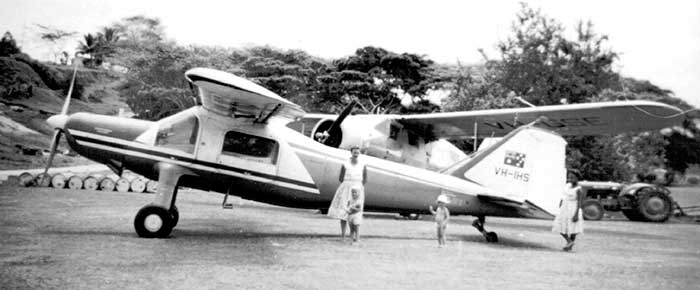
In centre is Mrs Ruth Hueter, wife of Monono missionary Rev. Robert Hueter, with their young daughter and son.
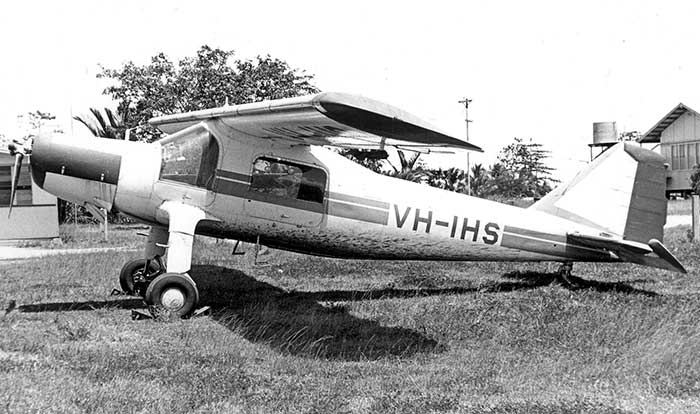
| Dornier Do 27H-2 c/n 2076 VH-GKE, VH-EXA |
| 60 |
Built by Dornier-Werke GmbH at Oberpfaffenhofen Airport, Munich, West Germany. Civil production |
| Purchased by Territory Airlines Ltd, Goroka | |
| Shipped from Germany as boxed cargo | |
| 2.61 |
Unloaded from ship at Madang
port. |
| 3.61 |
Assembled at Madang, flown to
Goroka |
| 27.3.61 |
Registered VH-GKE: Territory Airlines Ltd, Goroka, Papua New Guinea |
| Purchased by TAL
proprietor Dennis "Junior" Buchanan specifically to add capacity for
his Cessna 180s serving the growing Southern Highlands operations.
There TAL was successfully taking charter work to small airstrips
away from Ansett-MAL, which did not have suitable aircraft. Ansett-MAL
had retired the Ju 52s and Norsemans it acquired when it bought out Gibbes Sepik Airways. The Do 27 had the same engine as the TAL Piaggio P.166s, so parts were readily available. |
|
| 3.61 |
VH-GKE entered service with
TAL |
| 2.12.61 |
Territory Airlines pilot in
VH-GKE reported the blazing wreckage of Trans Australian Airlines
DHC-3 Otter VH-SBS on a ridge near Mount Hagen Airport PNG |
| VH-GKE suffered regular fuel
starvation problems resulting in rough runnng engine, and the engine
failure in flight. The airline's Chief Engineeer Paul Raasch was familiar
with German engineering techniques, and spent much time trying to
eliminate the fuel vapour-lock problems. |
|
| After 600 hours flying in the
New Guinea Highlands, TAL decided a Cessna 185 was more economical
for their operations than the Do 27. |
|
| Reader Lou Clarkeet has written: "I knew Junior Buchanan well, as in those days as I had responsibility for the Administration's radio network in the Eastern, Western and Southern Highlands and travelled with TAL frequently on regular flights or on charters. I remember that the Dornier Do 27 was a delightful aircraft to travel in with great visibility. Dennis Buchanan's decision to go to an all Cessna 185 fleet was a sensible one that he explained to me. It allowed hius chief engineer Paul Raatz to rationalise his spares and simplify compliance. According to Dennis the 185 had a comparable payload and was better priced." |
|
| 1.2.62 |
Change of ownership
and registration VH-EXA Executive
Air Services, Essendon Airport, Melbourne Vic EAS were agents for the Dornier and Aero Commander range. |
| 5.62 |
VH-EXA noted at Essendon in EAS hangar under maintenance, no titles |
| 25.7.62 |
Change of ownership:
Lutheran Mission, Madang PNG |
| c12.62 |
VH-EXA seen in the Lutheran
Mission hangar at Madang, also wreckage of VH-AMQ |
| 24.7.63 |
Struck-off Register,
owner's request |
| Sent to Germany for complete overhaul by Dornier | |
| 5.64 |
Restored to Register
VH-EXA: Lutheran Mission, Madang
PNG Operated by Lutheran Mission Aviation Services, Madang. (Chief Pilot Ray Jaensch) |
| (The DCA civil
register quotes the ownership when returned to the Register as Ansett-MAL,
Lae. However the compiler believes this was a clerical error, because all references state VH-EXA as being owned by the Lutheran Mission from 1962 until its crash in September 1964, and no evidence has been found that Ansett-MAL operated a Dornier.) |
|
| 3.9.64 |
Crashed
after takeoff, destroyed by fire, Surinam River, near Tauta PNG.
Pilot Ray Jaensch died, 1 passenger serious injuries, 3 passengers
unhurt. DCA accident report: "Engine power failed immediately after takeoff for undetermined reasons, and a forced landing had to be made on boulders in a river bed, during which the aircraft caught fire." |
| James Sinclair
wrote in his book series Balus Volume
II: "After purchase, the Lutheran mission Dornier had been returned to Germany for a complete overhaul, and had only been in service a short time before the fatal crash. On 3 September 1964, Ray Jaensch took off from Madang in VH-EXA bound for the new strip at Tauta, up the Surinam River not far from the wartime strip at Dumpu in the Ramu Valley. Tauta had been constructed by the local people, following encouragement from the Lutheran mission and the Administration, to enable their garden produce to be flown to market in Madang. The work had been supervised by a young patrol officer Tony Cooke. Passengers on the Dornier were Madang District Commissioner F. P. Kaad, District Medical officer Dr. Laurence Malcolm and Assistant District Officer Vin Smith. After inspecting the progress of the work at Tauta, the passengers re-boarded the Dornier for the return flight. Cooke accompanied them. Immediately on takeoff, Jaensch radioed Madang. He was having fuel trouble and would have to make a forced landing. There was no room to manoeuvre and the Dornier crashed into a rocky creek bed, about 14 Km from Tauta. Jaensch received severe head wounds and both legs were smashed. Fred Kaad suffered spinal injuries that were to confine him to a wheelchair for the rest of his life. The others escaped injury and pulled Jaensch and Kaad from the wreckage just before it was engulfed in flames. Jaensch’s Mayday was received in Madanfg and DCA alerted all aircraft in the vicinity to look for the Dornier. The blazing wreckage was quickly spotted by the pilot of a DC-3, who reported he could see five people nearby, three standing and two on the ground. He landed his DC-3 at Dumpu.” The account continues, describing the search and rescue attempts. Bryan McCook flying a TAL Cessna 185, glided down the steep-walled valley to locate the wreck, then flew to Goroka to collect a SAR storepedo, which he returned and dropped to the men. He was criticised by DCA for refusing to follow DCA Searchmaster’s instructions to stay away and wait for a helicopter, which did not arrive that day. McCook believes Jaensch died because of the delay and fought a bitter two-year war with DCA Administration. |
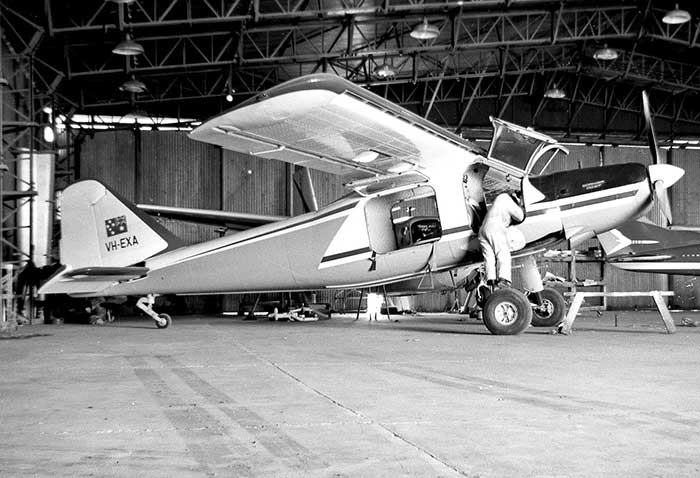
Photo by Geoff Goodall
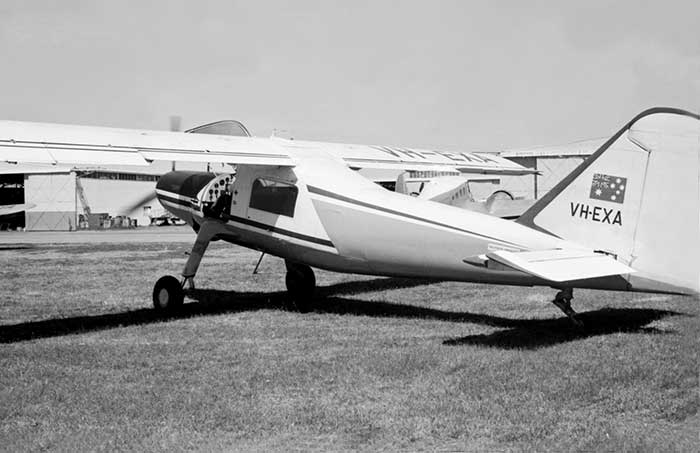
| Dornier Do 27H-2 c/n 2077 VH-CHR |
| 60 |
Built by Dornier-Werke GmbH at Oberpfaffenhofen Airport, Munich, West Germany. Civil production. |
| Sold to Catholic Divine Word Mission, Goroka, Papua New Guinea | |
| Shipped from Germany to New Guinea as boxed cargo | |
| 2.61 |
Unloaded from ship at Madang port. The first three Do 27s were packed in two crates. |
| 3.61 |
Assembled in Catholic Mission
hangar at Madang. Flown to Goroka. |
| 5.4.61 |
Registered VH-CHR
Divine Word Mission, Goroka,
Papua New Guinea |
| The mission requested
the registration, believed to signify Christ |
|
| Father Ivo Ruiter of Wirui Air
Services, Wewak endorsed other mission pilots on the Do 27. These
included New Guinea veterans Father Henry Hoff and Father Joe Walachy. |
|
| 9.5.61 |
Father Harry Mcgee was endorsed
on VH-CHR |
| 17.6.61 |
Crashed
at 9000 feet elevation on Mount Gisauka near Goroka. Pilot
Father Harry McGee was killed, no passengers. DCA Accident report: "The pilot attempted to fly over mountainous country without adequate visual reference and aircraft struck a mountain side probably in descent through cloud." When located, the aircraft was destroyed, some of the wreckage and cargo had burned. |
| 17.6.61 |
Wreck located by Bobby Gibbes,
who took off from Goroka and spotted the smoke from the burning cargo. |
| James Sinclair wrote in his
book Balus Volume II: "The Goroka Dornier was piloted by Father McGee, who was parish priest at Goroka. Aged 36, Father McGee came from Iowa USA and was ordained as a missionary priest in 1951. In 1954 he came to PNG. On Saturday morning 17 June 1961 Father McGee took off from Madang on a flight to Goroka. At 11.30am he made a radio call to the Goroka Tower reporting that he was in the Bena Gap at 13,000 feet, above heavy cloud. Nothing further was heard from him. At 1.15pm, Bobby Gibbes, flying a Cessna, located the wreckage of the Dornier near the top of Mount Gisauka, only a few minutes' flying time from Goroka. A ground party reached the site early the next morning and foiund Father McGee dead. He was the only occupant." |
|
| Accident location has also been erroneously reported as Mount Otto |
| 61 |
Built by Dornier-Werke GmbH at Oberpfaffenhofen Airport, Munich, West Germany. Civil production. |
| Purchased by Lutheran Mission, Madang | |
| 11.61 |
Arrived from Germany by ship
at Madang port. |
| 10.11.61 |
Registered VH-AMQ
Lutheran Mission, Madang, Papua
New Guinea |
| 11.61 |
Flown at Madang after assembly
by mission pilot Bryan McCook |
| 12.6.62 |
Crashed
during forced landing on hillside Mount Elimbari, Chuave PNG. Pilot Bryan McCook (flying experience 6,586 hours) was injured, 4 passengers including Monomo missionary Reverend Robert Hueter, were unhurt. DCA accident report: "The pilot allowed the selected fuel tank to become exhausted in flight and engine power could not be restored. The aircraft collided with trees in the subsequent forced landing on a hillside." |
| James Sinclair in his book
Balus Volume II quotes an
interview with Bryan McCook, who moved to PNG from NZ in 1961 to fly
for the Lutheran Mission aviation department, beside chief pilot Ray
Jaesnch. Bryan McCook: "Initially we operated the Super Cub, a Cessna 170 and a 182. Later a large Sunday School fund-raising effort from Europe and the USA presented us with a Dornier Do 27 VH-AMQ with the big 340hp engine to assist with lifting loads out of marginal airstrips. It was an excellent machine, but some tropical operational faults showed up later. On 12 June 1962, I had to make a forced landing in AMQ. I had left Monono with 4 passengers to go to Asaroka when the engine started spluttering up near Watabung. The weather was bad too, so I elected to try to return to Monono. Monono airstrip is on the south side of Mount Elimbari at an elevation of over 8,000 feet and at that time was only 1,000 feet in length. However, approching Chuave, there wasn't any hope of reaching Monono and I forced landed there up a rocky slope. I was the only person hurt, mainly because of leg whip through having my feet on the rudder pedals. I had lacerations to both shins but I was back on flying duties for the mission by July 1st. The subsequent DCA enquiry into the engine failure found some fault with the fuel system of the Do 27, which was later modified. AMQ was a total wreck and it was replaced by another Do 27 VH-EXA and I flew this machine for many hours, but seldom out of gliding distance from a forced landing area." |
|
| c12.62 |
Wreckage of VH-AMQ was seen
in the Lutheran mission hangar at Madang, with VH-EXA in service |
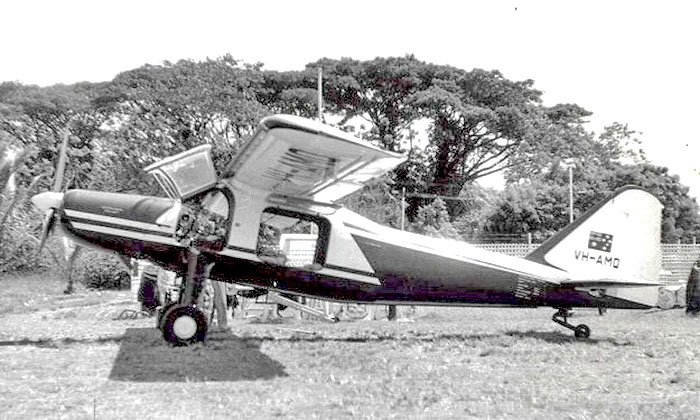
| .60 |
Built at Oberpfaffenhfen
by Dornier as military production of a total of 428 Dornier Do 27s
for the West German Air Force, Army and Navy |
| 8.7.60 |
Delivered to
West German Air Force/ Luftwaffe as KD+149 |
| 9.9.60 |
Issued to Air Depot 2, Diepholz
as CB+001 |
| 8.4.64 |
Sold by Luftwaffe to Dornier-Werke GmbH, Oberpfaffenhofen Airport, Munich |
| 23.4.64 |
Struck-off Luftwaffe strength |
| Prepared by Dornier for the civil market | |
| .64 |
Sold to Catholic
Mission of the Divine Word, Wewak, Papua New Guinea |
| 17.8.64 |
Shipped from Germany
to Wewak PNG, with VH-SHC and -SHD |
| The three boxed aircraft were
unloaded at Wewak port. Moved to Wirui airstrip at Wewak, where each
was assembled in the Wirui Air Services hangar. VH-SHB, SHC & SHD required removal of some military electrical/radio equipment, cabling and structures. Some modifications also had to be made to the electrical system to comply with DCA regulations and new radios installed. |
|
| The mission requested the registration
VH-SHB. The registration signified
Sacred Heart Brothers, which was a religious congregation for New Guinean men founded by the Bishop at Wewak, Bishop Leo C. Arkfeld, who later became Archbishop of Madang. |
|
| 23.3.65 |
Registered VH-SHB
Catholic Mission of
the Divine Word, Wirui airfield, Wewak, Papua New Guinea Operated by the mission aviation section, Wirui Air Services, based at Wirui airstrip at Wewak |
| 3.65 |
Test flight at Wirui |
| 27.3.65 |
Bishop Leo Arkfeld pilot log: his first flight in VH-SHB |
| 30.6.67 |
Crashed,
destroyed, Sassoya Gap near Wewak Father Larry Zampese lodged a flight plan Wirui to Yangoru then Kunjingini, carrying one passenger for each place plus cargo. Nine minutes after departing Wewak at 9.35am, he gave a Mayday call reporting engine failure, when his position was just beyond Sassoya Mission airstrip. Sassoya was only 5 Km from Wewak but behind a mountain range. VH-SHB crashed into heavily timbered mountains. |
| James Sinclair wrote in his
book Balus Volume II: "The pilot, Father Larry Zampese was Italian-born, aged 43 and had flown in the Royal New Zealand Air Force in the Second World War and as a commercial pilot in Australia and Europe. He was well experienced. Passengers were Mrs Mary Lalor, Commissioner of Girl Guides, and Father Desmond McKenna. Father Zampese radiod Wewak, reporting that he was having engine trouble and fast losing height. The aeroplane was flying over heavily timbered mountains and Zampese attempted to return to Sassoya Mission. he continued to lose height and crashed into the tree tops. Mrs Lalor and Father McKenna were killed instantly and Father Zampese died on the way to hospital." |
|
| Footnote: a New Guinea based
Cessna 185 VH-FLZ was later registered in memory of Father Larry Zampese |
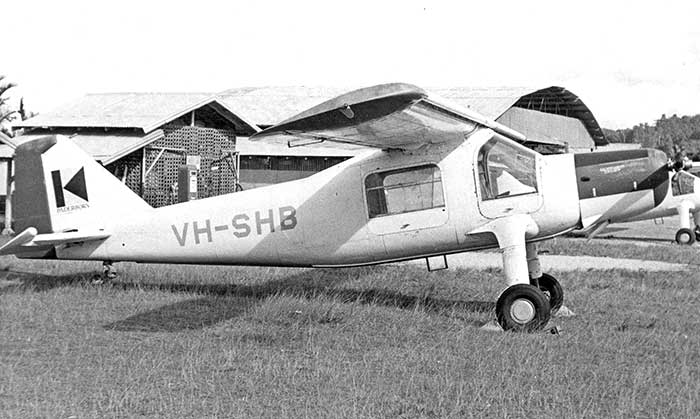
| 62 |
Built at Oberpfaffenhfen
by Dornier as military production of a total of 428 Dornier Do 27s
for the West German Air Force, Army and Navy |
| 10.9.62 |
Delivered to
West German Air Force/Luftwaffe. |
| 9.62 |
Issued to Air Transport Wing, Nebiberg as GA+371 |
| 25.3.64 |
Sold by Luftwaffe to Dornier-Werke
GmbH, Oberpfaffenhofen Airport, Munich. Airframe time: 138 hrs |
| Prepared by Dornier for the civil market | |
| .64 |
Sold to Catholic Mission of the Divine Word, Wewak, Papua New Guinea |
| 17.8.64 |
Shipped from Germany to Wewak PNG, with VH-SHB and -SHD |
| The three boxed aircraft were
unloaded at Wewak port. Moved to Wirui airstrip at Wewak, where each
was assembled in the Wirui Air Services hangar. VH-SHB, SHC & SHD required removal of some military electrical/radio equipment, cabling and structures. Some modifications also had to be made to the electrical system to comply with DCA regulations and new radios installed. |
|
| 16.9.65 |
Registered VH-SHC
Catholic Mission of the Divine
Word, Wewak, Papua New Guinea Operated by the mission aviation section, Wirui Air Services, based at Wirui airstrip at Wewak |
| 17.9.65 |
First flight
at Wirui |
| 5.2.73 |
Last flight in PNG, retired.
Total airframe time: 5,077 hrs 45 mins. Believed to be highest hour
Do 27. Wirui air Services had made 14,148 flights in this aircraft in eight years |
| 2.73 |
Sold to Rossair,
Parafield Airport, Adelaide SA, acting as agent for Skytours
Air Charters, Adelaide |
| 21.2.73 |
Arrived at Parafield on delivery
from Wewak by Wirui Air Service chief pilot Father Ivo Ruiter. He had as passenger Father Ed Baur who was on his way home to USA on leave. The ferry flight took 27 hrs 30 min flying time |
| 28.3.73 |
Change of ownership:
Brenton A. Miller, trading
as Skytours Air Charters, Adelaide SA |
| 29.4.74 |
Damaged at Leigh
Creek SA when starboard wing struck the ground during landing |
| 7.4.76 |
Change of ownership:
Second Karon Manufacturing
Pty Ltd, Melbourne Vic. Operated by: Bill Suhr/ Peninsula Air Services, Moorabbin Airport, Melbourne Vic |
| PAS proprietor Bill Suhr used
the Dornier for charter, as well as a contract with radio station
3XY for summer shark patrols along Melbourne beaches, sometimes towing
an advertising banner. PAS also operated a Republic Seabee for the
same work for radio station 3DB. |
|
| 16.4.81 |
Change
of ownership: Reg J. Ross trading
as Aero-Ads, Melbourne Vic |
| Used for advertising banner towing, based at Tyabb Vic | |
| 12.3.82 |
Minor damage at
French Island Vic |
| 22.9.83 |
Change of ownership: P. J. Bruce trading as Munro Aviation Pty Ltd, Launceston Tas |
| 26.4.84 |
noted at Devonport Tas, in hangar
having maintenance |
| 25.8.88 |
Change of ownership: Peter J. Sharman, Devonport Tas, trading as Devonport Aviation |
| Devonport Aviation used the
Do 27 for freight charters and scenic flights from an bush airstrip
at Cradle Mountain National Park. A supply dropping contract was awarded
by the National Park authority: dropping wooden boardwalk materials
from low level to construction teams laying boardwalk networks for
bush walkers at much lower cost than helicopters previously hired.
VH-SHC was fitted with a unique trolly load delivery system designed by a LAME at Devenport Airport. Devenporty Aviation's Peter Sharman describes the operation of the trolly: "It could be loaded up through the left rear passenger door and it had a huge spring to power it. We would neatly stack the trolley with 500 Kg of board, take off, then pull a lever and the trolley, assisted by gravity and a boot full of left rudder would slide sideways, the rear door would automatically open, the trolley would tip, the board would fall in a single bunch and then the trolley, released of its burden and powered by the spring would return back inside the fuselage closing the door behind it. The whole assembly could be fitted in place of the rear seats then removed again so the plane could return to scenic flight duties after dropping board. It was all legal and all fully approved. It was also tremendous fun! |
|
| Devonport Aviation's dropping business expanded when the Park authority hired VH-SHC to replace a helicopter to drop bags of composting material to bushwalkers’ composting toilets. It was on one of these dropping missions that the Dornier crashed. | |
| 9.2.92 |
Crashed
into trees near Cradle Mountain, Tasmania Stalled into trees in a valley, wrecked. The pilot, dropmaster and 2 passengers were unhurt |
| Devonport
Aviation's Peter Sharman describes the dropping of bags of composting
material: "We would remove the rear seats or the board walk dropping carriage and with a dropmaster kneeling in the rear of the plane would throw out bags of composting material, which was used in the heavily utilised toilets in the Cradle Wilderness. It was on a day of compost dropping operations when I was flying a Beaver when the call came through from Melbourne Flight Service to fly to the site of the plane crash. I was returning to Cradle Mountain after servicing a mining camp in Tasmania’s South West Wilderness when I was contacted via radio. I was the only known traffic in the area. As I circled the crash site I was surprised to see four people standing in a clearing near the wreck. I was instructed to hold if possible until a helicopter arrived to pick them up. Earlier that day I had left a young pilot in my employ to drop compost to the Waterfall Valley hut. He had loaded up the plane with compost, illegally put two of his friends on board as well as the drop master and he was flying up the valley on the drop run - instead of down the valley. He was operating completely contrary to instructions. The pilot had stalled the Dornier at full power in the lee of a precipitous mountain called Barn Bluff from a height of about 50 feet above ground. It came down through some scrubby forest to rest on the valley floor. His two rear occupants had no seats and no seatbelts. It is testimony to the Dornier’s incredible strength and to pure luck that none of the four on board were injured. My favorite toy was bent beyond repair." |
|
| The wreckage of VH-SHC was salvaged
from the crash site. Later acquired by a German group of Do 27 enthusiasts
and shipped to Germany to be used as parts to assist the group to
refurbish the former P2-UIE purchased by the same group and flying
in Germany as D-ENTE |
|
| Peter Sharman advertised his
collection of Do 27 parts for sale: - wreck of VH-SHC - P2-UIE dismantled, shipped from PNG in January 1990 - remaining parts of VH-IHS & VH-SHD shipped from PNG in January 1990 |
|
| 8.93 |
Collection purchased by Martin
Rulffs and associates, Frankfurt, Germany |
| .93 |
Shipped to Germany |
| Parts used in the rebuild of
P2-UIE to airworthy condition in Germany |
|
| 2.9.97 |
Struck-off Australian
Register |
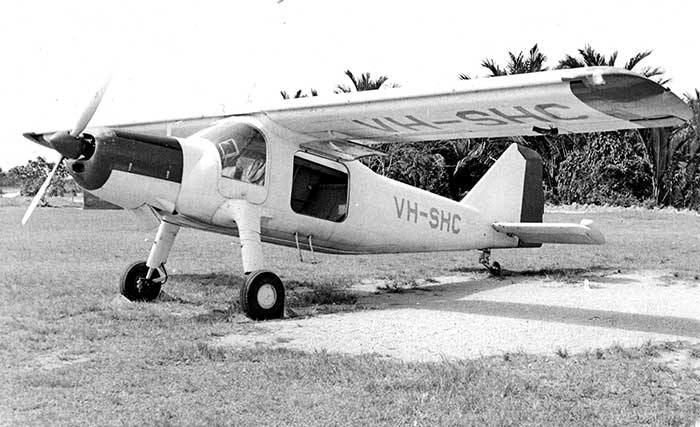
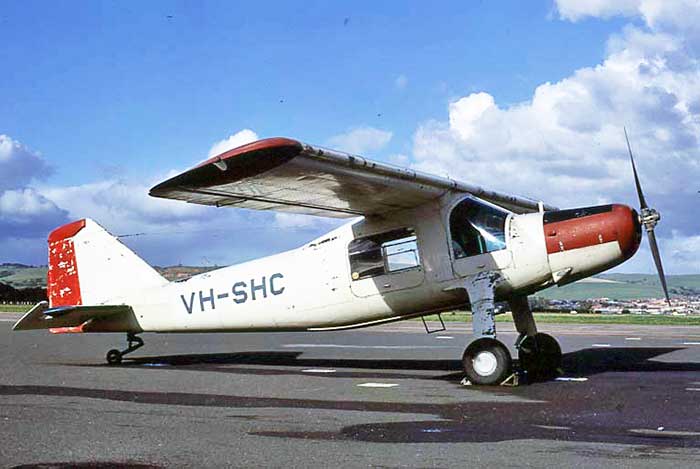
Photo by Mike Madden
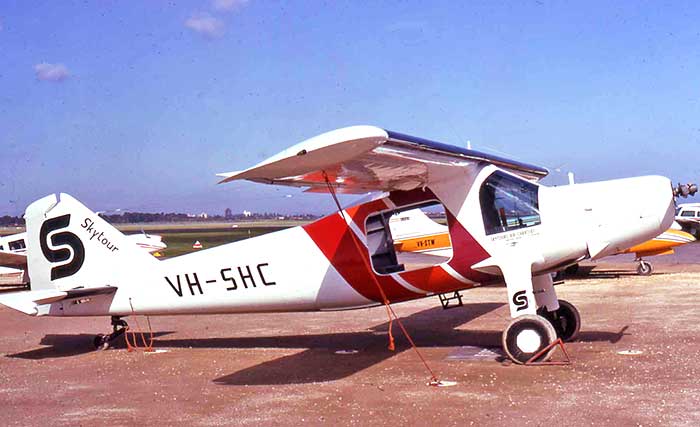
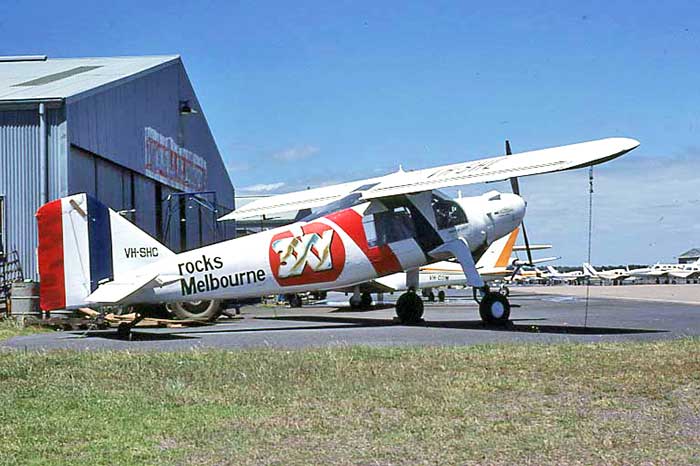
Note the extra air scoop on the top of the cowling and banner towing hitch under the tailplane.
Photo by Trevor W. Boughton
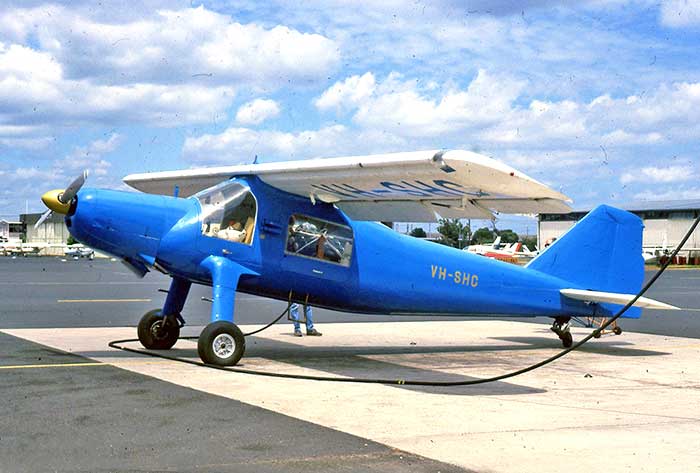
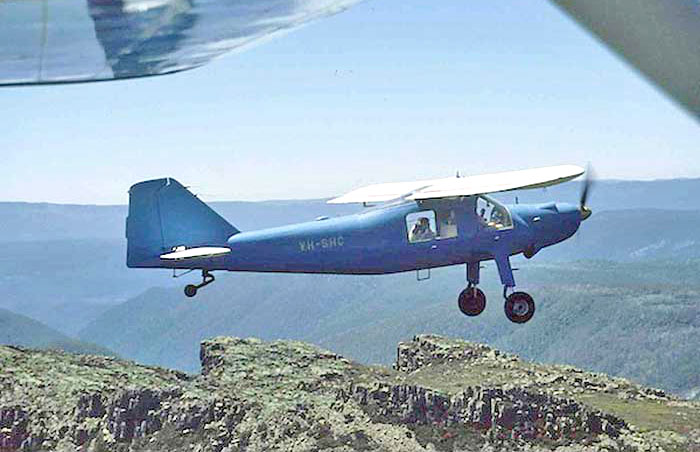
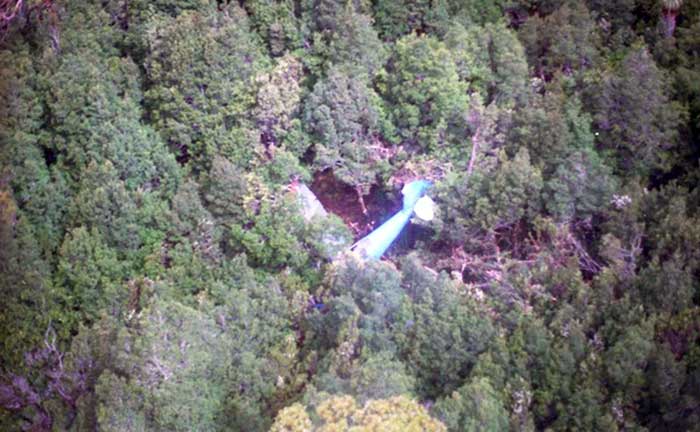
Photo: Devonport Aviation
| .62 |
Built by Dornier-Werke
GmbH at Oberpfaffenhofen Airport, Munich, West Germany as military
production of a total of 428 Dornier Do 27s for the West German Air
Force, Army and Navy c/n 526 was the last military A-4 version built |
| 12.10.62 |
Delivered to West German Air Force/Luftwaffe |
| 10.62 |
Issued to Air Transpoprt Wing
62, Cologne-Waan as GB+379 |
| 9.4.64 |
Sold by Luftwaffe to Dornier-Werke
GmbH, Oberpfaffenhofen Airport, Munich. |
| 23.4.64 |
Struck-off Luftwaffe strength |
| Prepared by Dornier for the civil market | |
| .64 |
Sold to Catholic Mission of the Divine Word, Wewak, Papua New Guinea |
| 17.8.64 |
Shipped from Germany to Wewak PNG, with VH-SHB and -SHC |
| The three boxed aircraft were
unloaded at Wewak port. Moved to Wirui airstrip at Wewak, where each
was assembled in the Wirui Air Services hangar. VH-SHB, SHC & SHD required removal of some military electrical/radio equipment, cabling and structures. Some modifications also had to be made to the electrical system to comply with DCA regulations and new radios installed. |
|
| 21.9.65 |
Registered VH-SHD
Catholic Mission of the Divine
Word, Wirui airstrip, Wewak, PNG Operated by the mission aviation section, Wirui Air Services, based at Wirui airstrip at Wewak |
| 22.8.69 |
Crashed
during landing at Kunjingini, near Wewak PNG. Pilot Jerry
Jaromin and four passengers, comprisng two Catholic Fathers and two
local men. Only minor injuries. DCA accident report: "During the landing roll at Kunjingini, the aircraft struck a horse and swerved into a ditch." The pilot saw the horse near the strip but considered it was placid and continued his approach to land. As he touched down the horse ran on to the runway in the path of the aircraft. After impact the aircraft veered to the right and struck a drainage ditch which ran parallel to the strip. Both main landing gear legs were torn back against the fuselage, whiuh was badly damaged. The horse was killed instantly by the collision and its carcass was cut up and taken away within 30 minutes by the local population as food. |
| Damaged aircraft dismantled
at Kunjingini by Wirui Air Services staff and moved back to Wewak
by road |
|
| Damage to severe to be repaired
in PNG. Aircraft was written-off. |
| .60 |
Built by Dornier-Werke GmbH at Oberpfaffenhofen Airport, Munich, West Germany as military production of a total of 428 Dornier Do 27s for the West German Air Force, Army and Navy |
| 10.5.60 |
Delivered to
West German Air Force/Luftwaffe as KD+130 |
| 30.8.60 |
Issued to Air Transport Wing
61, Neubiberg as GA+375 |
| 21.8.64 |
Issued to 1 Air Rescue and Liaison
Squadron, Furrstenfeldbruck as LA+155 |
| 9.12.64 |
Issued Pilot Candidate Screening
Regiment, Uetersen as AC+912 |
| 13.11.67 |
Re-serialled 57+41 |
| 20.5.70 |
Issued Air Depot 6, Oldenburg
for storage pending disposal |
| Civil disposal |
|
| 21.2.71 |
Registered D-EAEI
Afrika-Kreis e V., Mettingen,
West Germany |
| 18.3.71 |
Issued to Dr. W. Otte for religious/sociological
research |
| Operated by the Catholic
Mission in Belgian Congo |
|
| 22.6.73 |
German CofA expired |
| 8.73 |
Struck-off West
German Register |
| Locasted in Germany. Purchased by Catholic Mission of the Divine Word, Wewak, PNG | |
| Shipped from Germany to Wewak
by Society for Economic Aid for Developing Countries |
|
| 1.74 |
Unloaded from ship at Wewak
port. |
| 1.74 |
Assembled in the Catholic mission
hangar at Wirui airstrip, Wewak by mission pilot/engineer Denis Beahan Aircraft had a id. plate stamped with "VH-UIE" when assembled. Airframe time 800 hours. |
| 8.2.74 |
Registered VH-UIE
Catholic Mission of the Divine
Word, Wirui airfield, Wewak, PNG Operated by the mission aviation section, Wirui Air Services, based at Wirui airstrip at Wewak |
| Photo at Wewak
shows yellow paint scheme, with VH-UIE painted on a white panel on
fuselage |
|
| 8.2.74 |
First test flight after assembly,
pilot Ivo Ruiter. Based on interpretation
of log book entries, not confirmed |
| 11.2.74 |
Bishop Leo Arkfeld pilot log:
his first flight in VH-UIE |
| 15.5.74 |
Re-registered P2-UIE Wirui Air Services/ Franair, Wirui airstrip, Wewak PNG |
| 3.2.75 |
P2-UIE noted at Port Moresby,
same yellow paintwork, registration on the same white panel on fuselage |
| 30.6.76 |
P2-UIE made the last departure
from Wirui airstrip, which was closed to operations effective the
next day. Father Ivo Ruiter flew it on the short hop to Wewak-Boram Airport, where WAS was now to be based. |
| 17.10.83 |
Last flight in PNG. Retired
with airframe time 3,399 hrs 15 mins |
| 10.83 |
Retired at Boram Airport, Wewak
because of structural cracks in both landing gear attachment fittings,
caused by a heavy landing. Further inspection revealed corrosion
in the leading edge of the wing around the leading edge slats. The
repair could not be carried out by Wirui Air Services reduced maintenance
staff. |
| Wirui Air Services decided the
cost of repair was not justified and placed the aircraft up for sale
"as is". The Dornier was replaced P2-UIE with Cessna 182/Wren 460 P2-UIH |
|
| PNG Civil Aviation Authority
ruking that a P2- registered aircraft could not be sold outside PNG
without a current CofA stopped sales propects. The requirement was
finally dropped in 1989. |
|
| .89 |
Sold to Peter J. Sharman, Devonport Tas, trading as Devonport Aviation. He was operating VH-SHC |
| P2-UIE was dismantled at Wewak and packed in a sea container. As many remainming Dornier spares and usable parts from the crash wrecks of VH-IHS and VH-SHD were also packed into the container. | |
| 1.90 |
Shipped from Wewak to Tasmania. |
| The Do 27 parts collection were
to be used to maintain Devonport Aviation's VH-SHC. When VH-SHC was wrecked in a crash in tasmania 19.2.92, its wreckage was salvaged and added to the collection, which was advertised for sale. |
|
| P2-UIE and other Do 27 parts
were sold to Martin Rulffs
and associates, Frankfurt, Germany |
|
| 8.94 |
Shipped from Tasmania to Germany,
where the collection of Do 27s was collected in October 1994 |
| P2-UIE commenced airwotrthy
rebuild by Rulffs' group of Do 27 enthusiasts, using some of the other
parts shipped from Tasmania. The entire wing was replaced due
to the corrosion problems. |
|
| .97 |
Registered D-EBTF Martin Rulffs, Frankfurt, Germany |
| .07 |
First flight after rebuild in
Germany |
| 9.07 |
Re-registered
D-ENTE Painted in the same zebra stripe black & white paint scheme as the original Do 27 D-ENTE (c/n 2001) which made an animal conservation expedition to Africa in 1958-1959. It had crashed in Tanazania on 10 JAnuary 1959, killing the expedition leader Michael Grzimek. |
| 31.8.08 |
Departed Egelsbach,
Germany for Africa to commemorate the original flight. |
| 18.9.08 |
Damaged at Lokichoggio, Kenya.
Transported to Germany for a year-long rebuuild |
| 14 |
D-ENTE flies in
the zebra stripe black and white paint scheme |
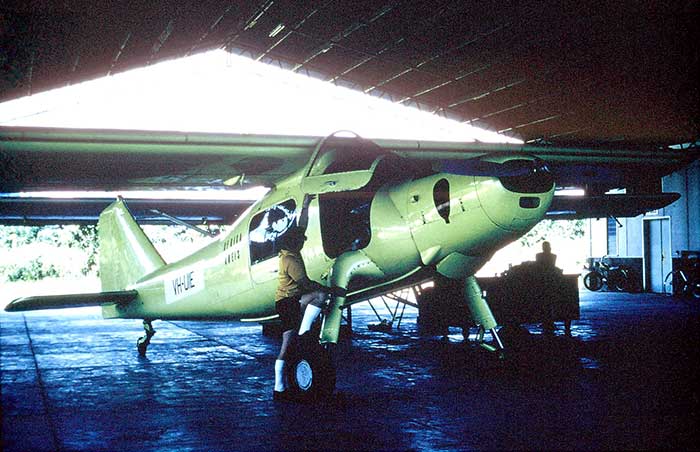
Photo: Ben Dannecker collection
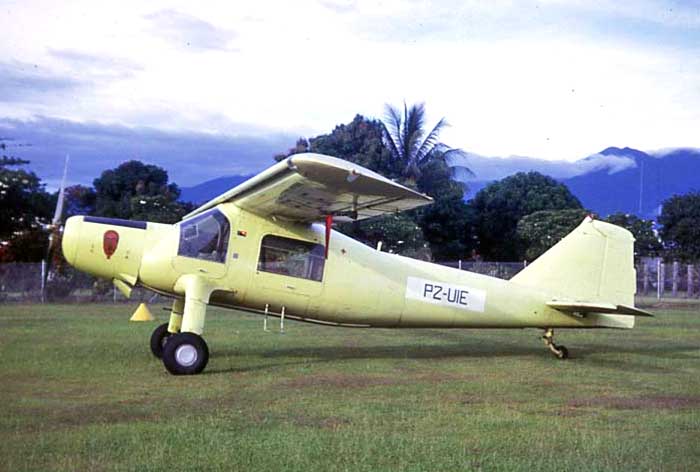
Photo by Dave Thollar
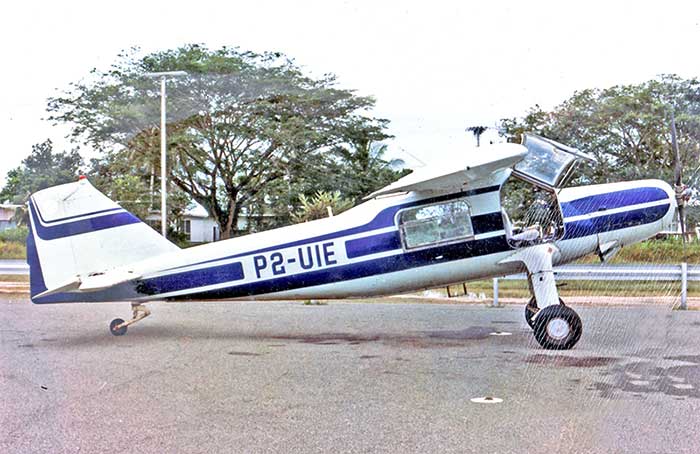
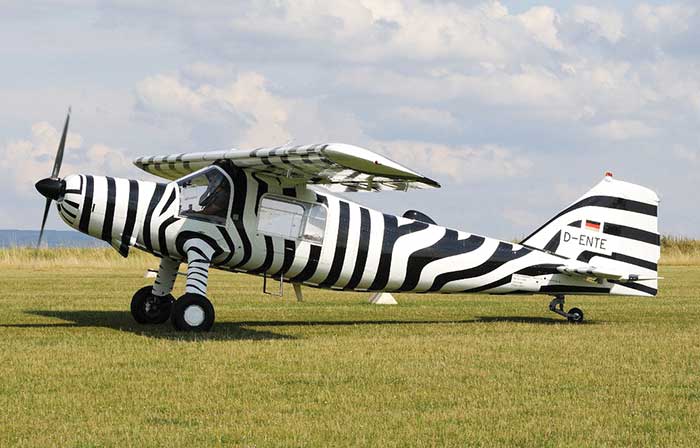
D-ENTE
at Bad Gandersheim, Germany on 16 August 2008, just before the commemorative
fight to Africa.
Photo by Tim Spearman
Photo by Tim Spearman
It was imported in September 1965 by the Dornier agents Executive Air Services , Melbourne.
The Do 28B-1 was a revised Do 28A with enlarged nose, additional fuel tanks, enlarged tailplane, 290 hp Lycoming IO-540 fuel injected engines and three-blade constant speed propellers. 60 of this model were built. A later development was the Do 28D Skyservant
| .65 |
Built by Dornier-Werke
GmbH at Oberpfaffenhofen Airport, Munich, West Germany |
| .65 |
Registered D-IDUN |
| 11.9.65 |
D-IDUN arrived
at Melbourne-Essendon Vic on delivery from Germany to Australian agents
Executive Air Services. White with red trim. |
| 2.11.65 |
D-IDUN noted Essendon in EAS
hangar. Also 26.11.65 |
| 25.2.66 |
noted at Essendon in EAS hangar
now painted as VH-EXA |
| 1.3.66 |
Registered VH-EXA
Executive Air Services
Pty Ltd, Essendon Airport, Melbourne Vic |
| 3.66 |
Immediately leased for an magnetometer
mineral survey contract for Aero Service Ltd, Sydney, the Australian
associate of US survey company Aero Service Corp, Philadelphia PA. Aerial survey specialist Doug Morrison of Sydney adds to the story: "The Dornier Do 28 was used to finish off a contract for BHP that had been dragging for a year in South West Tasmania. It had been commenced with the magnetometer-equipped DC-3 VH-MJR in March 1965 (I was on the DC-3) then continued by the Aero Commander VH-MJJ. The Aero Commander VH-MJJ had a nose wheel failure at Burnie or somewhere on the north coast of Tasmania while on that contract, with ex-Adastra Aerial Surveys Chief pilot Ted McKenzie flying. I recall the Aero Commander had other commitments and Aero Service Ltd could not afford to leave it sitting in Tasmania waiting for good weather, so the Dornier was temporarily geared up with a tow bird installation. I think the Dornier Do 28's pilot for that magnetometer survey was Ian Bell from Executive Air Services." |
| 6.3.66 |
VH-EXA noted at
Hobart Airport, Tasmania, fitted with mineral survey gear in the cabin
and a trailing magnetometer "bird" under the belly. Also 22.3.66. |
| 66 |
Department of National Development
National Mapping section (Natmap) hired VH-EXA from Executive Air
Services for a month's contract in support of a large mapping project
of Australian inland desert areas. Crewed by 3 Natmap specialists and flown by EAS pilot Ian Bell. The Dornier was flown to remote locations in South Australia, Western Australia and Queensland. Among the landings were Maralinga, Giles, Swindell Field, Kidson Field, Neale Junction, Alice Springs, Warburton Mission, Carnegie Station and the dry Serpentine Lakes on the SA/WA border. |
| 10.9.66 |
Flew demonstrations
at the National Air Show, Adelaide-Parafield SA. White & red,
no titles. |
| 11.11.66 |
noted at Sydney Airport, same
red & white scheme, no titles |
| 4.67 |
Delivered to Port
Moresby PNG on extended lease to Aerial
Tours Pty Ltd, Port Moresby. Founded by Dennis Douglas, Aerial Tours grew quickly as a charter operator and took over Ansett-MAL's Light Aircraft Division scheduled airline routes in the Sepik District of PNG. By 1971 the company had 13 twins, and three Cessna 206s based at Wewak, Vanimo, Kiunga, Daru, Kerema and Port Moresby. |
| 30.11.67 |
Re-registered
VH-ATR Executive
Air Services Pty Ltd, Essendon Airport, Melbourne Vic Leased to Aerial Tours Pty Ltd, Port Moresby, PNG |
| 19.1.68 |
Damaged landing Port Moresby
on a pilot training flight. At the end of the landing run, the
tail of the aircraft lifted and the port prop struck the runway resulting
in damage to the tips of the prop. Pilot Ian Cruikshank |
| 12.2.70 |
Change of ownership: Aerial Tours Pty Ltd, Port Moresby, PNG |
| 16.6.72 |
Struck-off Register as sold to Luxembourg |
| .72 |
On-sold to Heyl
Ha'Avir / Israeli Air Force. Serial number 016 |
| 21.10.73 |
Departed Abu Rhodes on a patrol
during the Yom Kippur War. Shot down by a SAM-3 missile fired
by an Egyptian Air Force Mig 21. The Dornier's three Israeli Air Force
crew members survived but were captured, becoming Prisoners of War. |
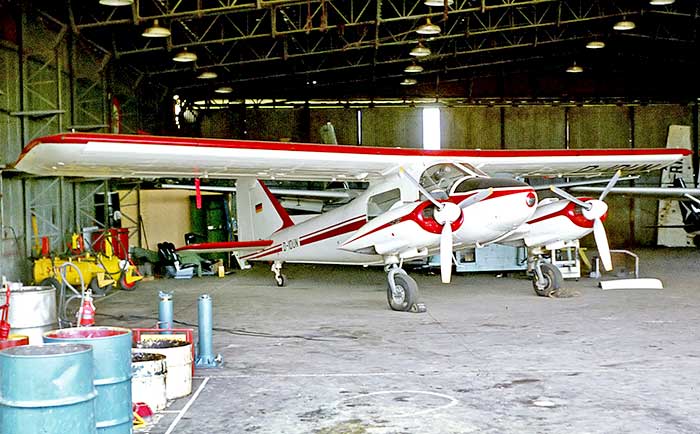
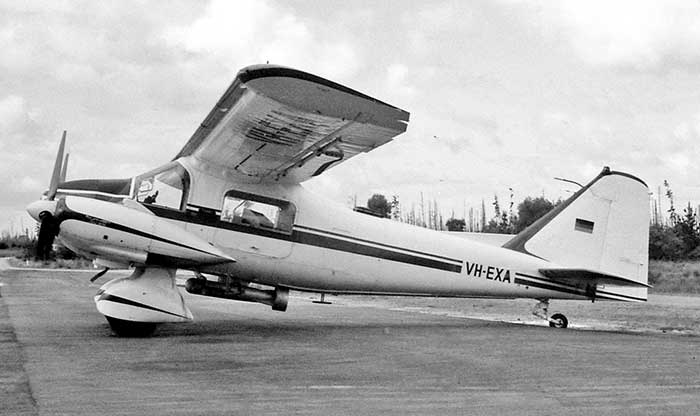
Photo by David Eyre
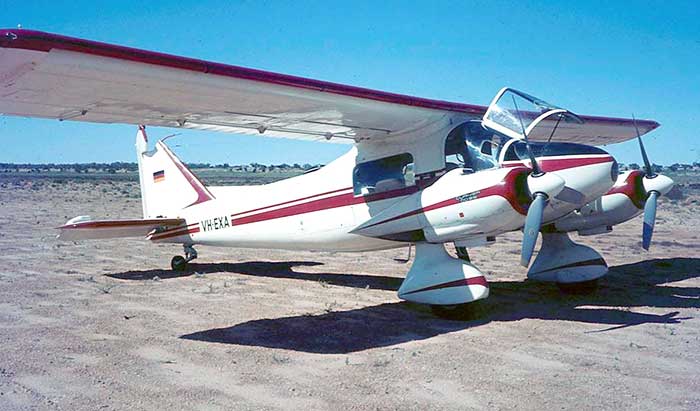
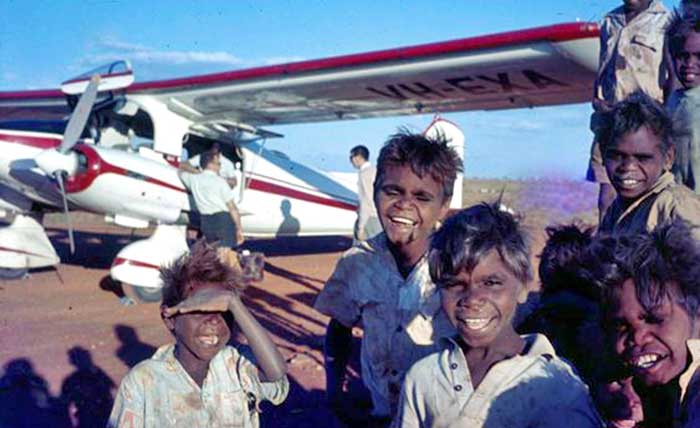
Refuelling
at the Warburton aboriginal community in WA in 1966.
Photo: Des Young
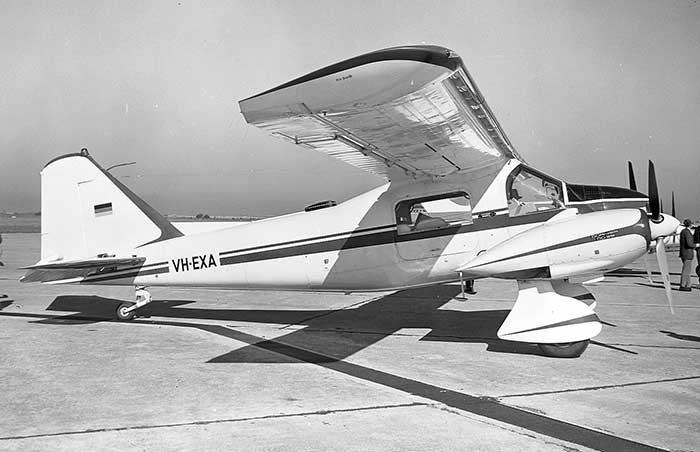
| VH-EXA
was demonstrated at an Adelaide airshow in September 1966, clean
and polished after months of dusty outback airfields during the survey operations. Photo by Geoff Goodall |
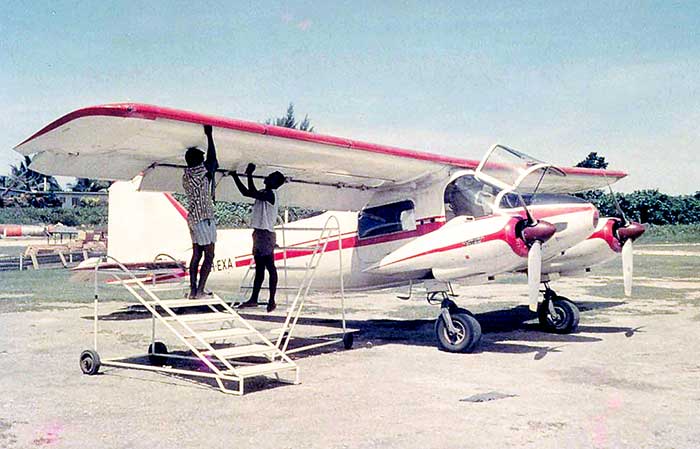
Ben Dannecker collection
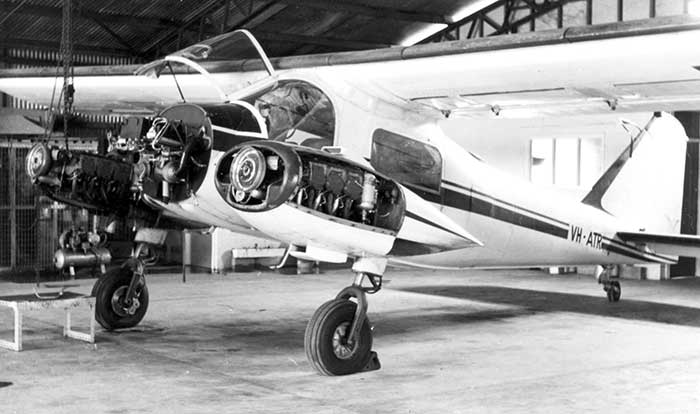
Photo by Allan Bovelt
- Australian Civil Aircraft Register, Department of Civil Aviation
- Accidents to Australian Civil Aircraft, DCA: annual publication, 1960-1966
- Aviation Historical Society of Australia - Civil Aircraft Register Supplements
- Papua New Guinea Operators listings, 1968-1973, Allan Bovelt/Pacific Island Aviation Society
- Historic Civil Aircraft Registers of Papua New Guinea, Tony Arbon & David Sparrow, AustAir Data, c1984
- Australia, NZ and SW Pacific Islands Registers 1977, Air Britain, 1977
- Australian Air Log, monthly journal, 1965-1968
- Balus - The Aeroplane in Papua New Guinea, Volume II, The Rise of Talair, James Sinclair, Robert Brown & Assoc, 1988
- The Illustrated Encyclopedia of Aircraft in Australia & NZ, David Eyre, Sunshune Books, 1983
- German Military Aviation 1956-1975, Paul A. Jackson, Midland Counties Publications, 1979
- Desert Flight of the Dornier, Des Young: www.natmap.org/adnm/docs/DORN/Dornier
- Some Impressions of Aviation in PNG, Trevor W. Boughton, AHSA Journal, February 1963
- correspondence from Tim Hueter, son of Lutheran missionary Reverend Robert Hueter
- correspondence from Lance Hill re Israeli fate of Do 28 VH-EXA
- Ben Dannecker for information on Australian Do 27s
- Doug Morrison, Australian aerial survey historian.
- Father Pat Fincutter, who flew many hours on the Wirui Air Services Do 27s, for his corrections and extensive additional information
- Martin Rulffs, Germany: who purchased VH-SHC & P2-UIE, provided his listing of all Australian Do 27s